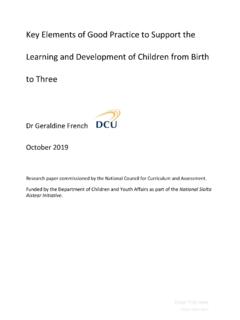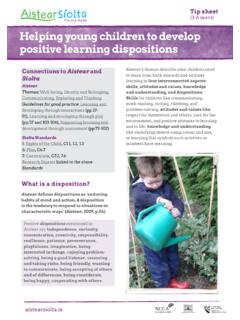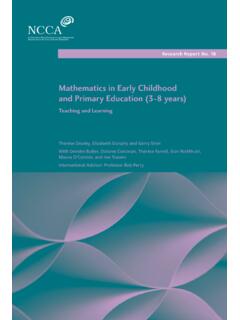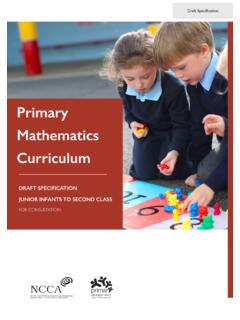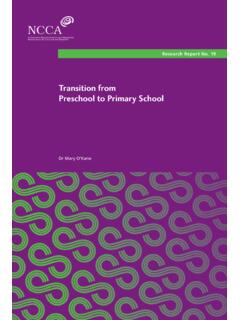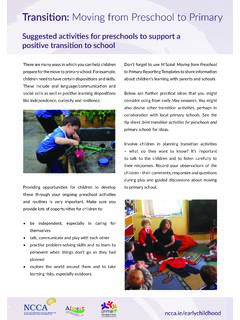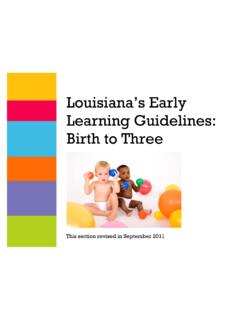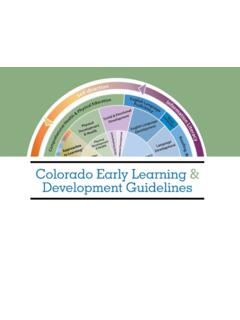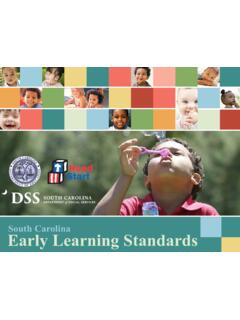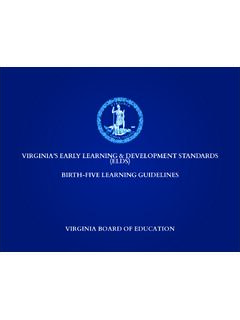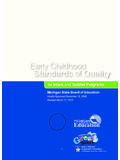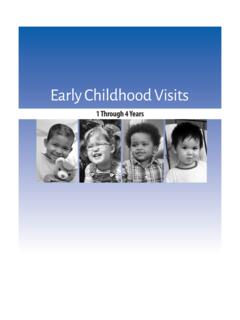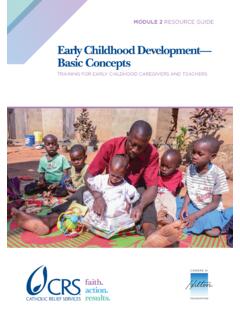Transcription of G uidelines f or g od p r a c t i c e - NCCA
1 guidelines for good practice NCCA 2009. National Council for Curriculum and Assessment 24 Merrion Square, Dublin 2. Aistear: the Early Childhood Curriculum Framework Contents Introduction 5. Building partnerships between parents and practitioners 6. Introduction 7. What are partnerships? Why are they important? 7. Partnership in action 8. Supporting learning and development 8. Sharing information 12. Contributing to the setting 19. Making decisions and advocating different approaches and courses of action 22. Conclusion 25. learning and developing through interactions 26. Introduction 27. How can I have good interactions with children? 27. What interaction strategies can I use? 28. Sample methods: Further information 31. Children learning together 46. How can I support interactions between children?
2 46. Conclusion 51. learning and developing through play 52. Introduction 53. What is play? 53. Are there different types of play? 53. Where do children play? 55. What is my role as the adult in play? 56. How do I prepare the play environment? 56. How do I help children who find it difficult to play? 59. How can I use play across Aistear's four themes? 60. Conclusion 70. Supporting learning and development through assessment 71. Introduction 72. What is assessment? Why is it important? 72. What do I assess and when? 74. What information do I document, why and how? 74. How do I store assessment information and for how long? 76. How do I use the information I collect and document? 77. With whom do I share information and how? 77. What information should I gather from parents? 78. How do I collect assessment information?
3 79. Five assessment methods 80. Self-assessment 81. Conversations 84. Observation 87. Setting tasks 93. Testing 98. The challenges and strengths of assessment methods 101. Conclusion 102. 3. Aistear: the Early Childhood Curriculum Framework Appendix 1: Resources for play 103. Appendix 2: Legislation, regulation and assessment 107. Bibliography 109. Figures Figure 1: Definition of partnership 7. Figure 2: Extract from Paul's daily diary 18. Figure 3: Definition of assessment 72. Figure 4: Assessment methods 80. Figure 5: Types of observation 87. Tables Table 1: The benefits of parents and practitioners working together 8. Table 2: A range of interaction strategies 28. Table 3: Building relationships 29. Table 4: Facilitating 29. Table 5: Organising 30. Table 6: Directing 30. Table 7: Characteristics of play 53.
4 Table 8: Categorising play 54. Table 9: Enriching and extending learning through play 56. Table 10: The adult's changing role in play during early childhood 58. Table 11: Thinking about assessment 72. Table 12: Features of good assessment practice 73. Table 13: Documenting children's learning and development 75. Table 14: Challenges and strengths 102. 4. Aistear: the Early Childhood Curriculum Framework Introduction Aistear is the curriculum framework for children from birth to six years in Ireland. It describes learning and development through the four interconnected themes of Well-being, Identity and Belonging, Communicating, and Exploring and Thinking. Four sets of guidelines , focusing on different aspects of pedagogy, describe how the adult can support children's learning and development across these themes.
5 The guidelines focus on building partnerships between parents and practitioners learning and developing through interactions learning and developing through play supporting learning and development through assessment. The guidelines describe good practice and use a number of learning experiences to show what this practice might look like. While these learning experiences usually focus on a particular age group of children and a particular type of setting, many of them can be adapted to suit other age groups and other settings. Thinking about my practice questions help the adult reflect on what he/she does and says to support children's learning and development. There are many connections across the four sets of guidelines . For example, many of the learning experiences in an individual set can support practice in the other guidelines .
6 5. Building partnerships between parents and practitioners Aistear: the Early Childhood Curriculum Framework Building partnerships between parents and practitioners Introduction Parents are the most important people in their children's early lives. Children learn about the world and their place in it through their conversations, play activities, and routines with parents and families. Parents can also support children's learning in out-of-home settings, such as childminding settings, cr ches, playgroups, pre-schools, and primary schools. By working together parents and practitioners can enhance children's learning and development. All parents need support at some time or another. For example, the loss of a loved one, a money problem, or ill health might mean that they need extra help. Time constraints, poverty, social and economic background, cultural identity, discrimination, previous negative experiences, literacy difficulties, language, or different disabilities, can also make it difficult for parents to participate in their children's learning and development as much as they might like to.
7 While partnership can benefit all parents and families, parent/practitioner partnerships can be especially important for these families. These guidelines outline what partnership means and describe different ways in which parents and practitioners can work together. What are partnerships? Why are they important? Figure 1: Definition of partnership Partnership involves parents, families and practitioners working together to benefit children. Each recognises, respects and values what the other does and says. Partnership involves responsibility on both sides. Increasingly, the early care and education of babies, toddlers and young children is shared among parents, families and practitioners. A partnership approach between these people is very important, especially at times of change in children's lives.
8 These times might include settling in to a new setting, getting to know a new practitioner, or getting used to a new baby at home. Other critical times might be when children experience bereavement, are upset or worried, or feel left out or different in a negative way. By working together and sharing information parents and practitioners can help make these times in children's lives easier. Good partnerships are built on trust. Practitioners need to respect the confidentiality of information they receive about children, while understanding that confidentiality cannot be guaranteed for example in cases involving child protection Table 1 outlines the benefits of good partnerships for parents, practitioners and children. 1. See Children First: National guidelines for the Protection of Children (Department of Health and Children, 1999), Our Duty to Care: the principles of good practice for the protection of children and young people, (Department of Health and Children, 2002) and Child Protection guidelines and Procedures (Department of Education and Science, 2001).
9 7. Aistear: the Early Childhood Curriculum Framework Building partnerships between parents and practitioners Table 1: The benefits of parents and practitioners working together Parents Practitioners Children feel valued and respected understand better the children and feel more secure and benefit more are more involved in their children's families in their settings and use from the educational opportunities learning and development this information to make learning given to them can share information about their more enjoyable and rewarding for move from one setting to another children all children with greater confidence feel their family's values, practices, can help children develop a sense see learning as more enjoyable traditions, and beliefs are of identity and belonging in the when their home life is visible' in understood and taken into account setting by actively engaging with the setting and finding out about family values, enjoy hearing and seeing their home feel comfortable visiting the setting.
10 Traditions and beliefs, and building language in the setting when their talking to, and planning with on these where appropriate home language is neither English practitioners benefit from parents' skills and nor Irish know more about their children's expertise experience more connections experiences outside the home and . use this information to support can provide a more emotionally between the different services that their learning and development secure environment for children. support them. more effectively understand why early childhood care and education is important have increased confidence in their own parenting skills. Partnership in action There are many different ways in which parents and practitioners can work together. These guidelines focus on four: supporting learning and development sharing information contributing making decisions and advocating different approaches and courses of action.
